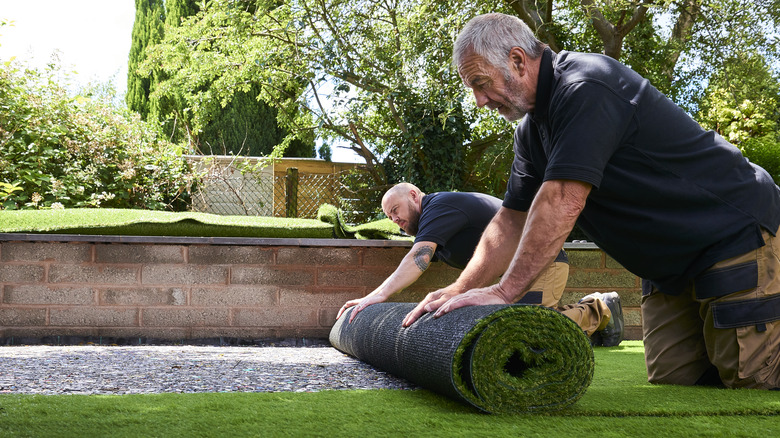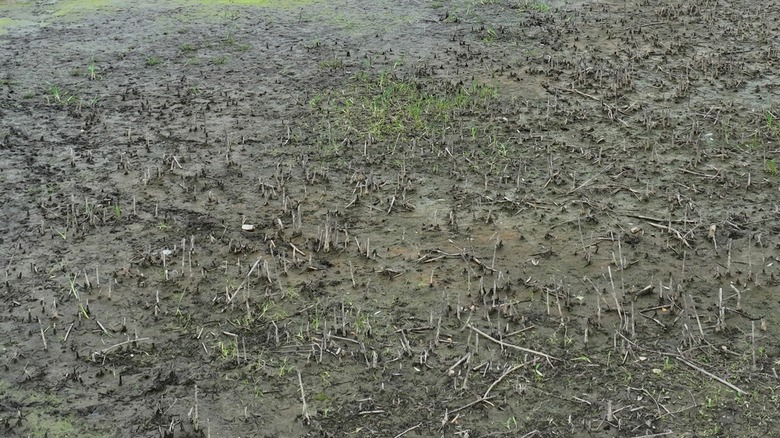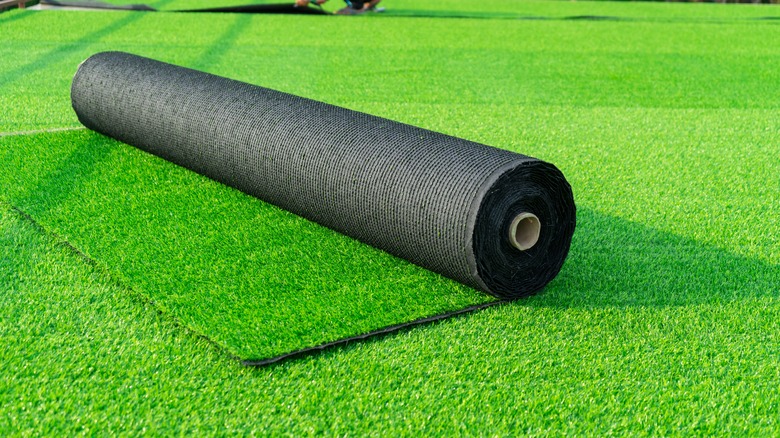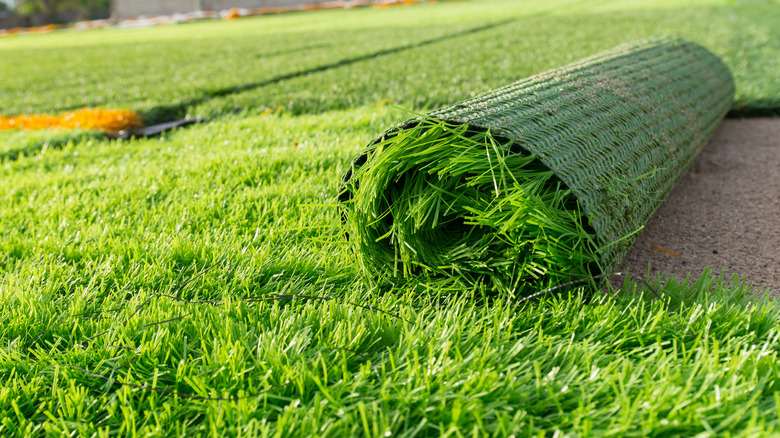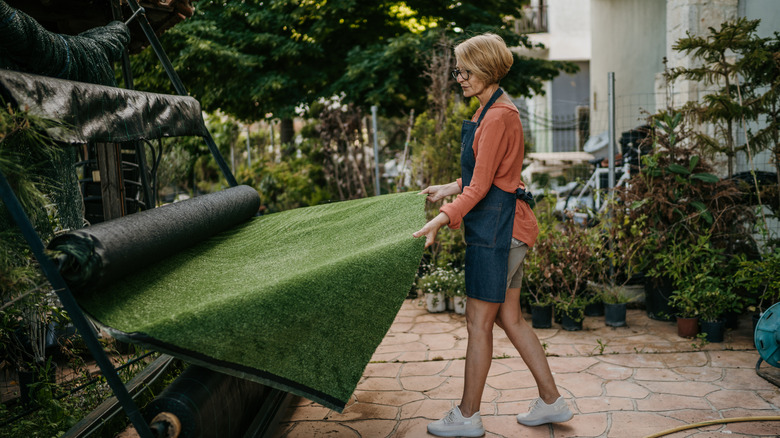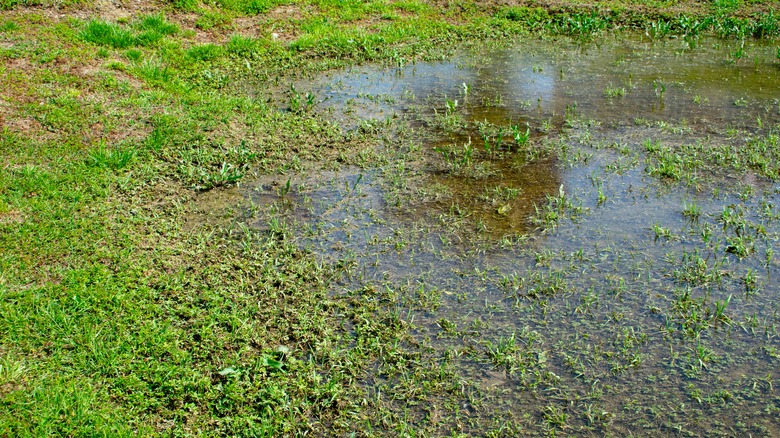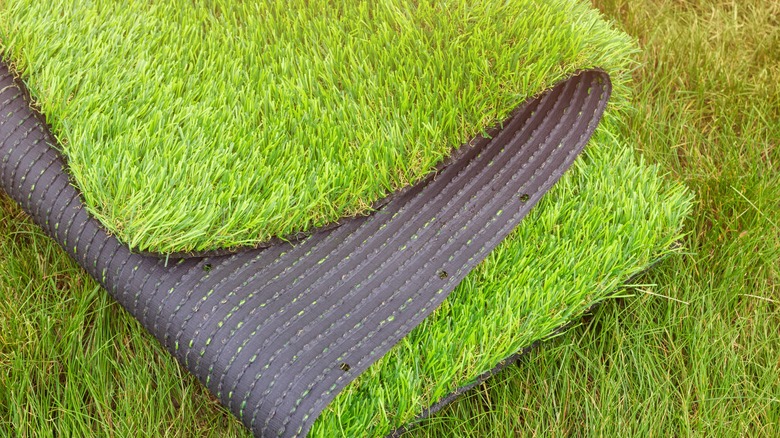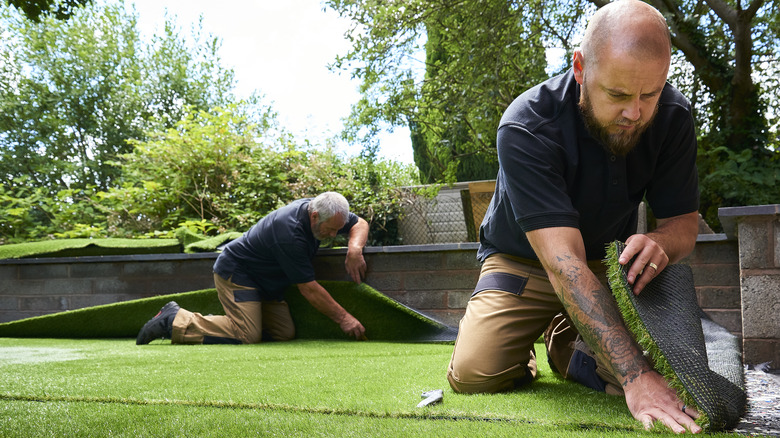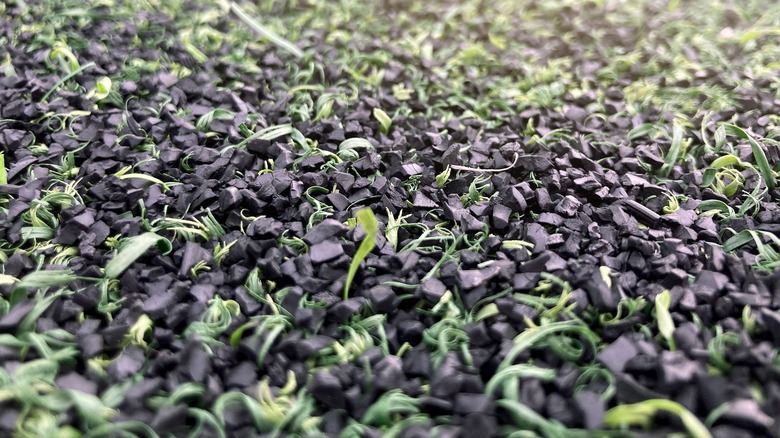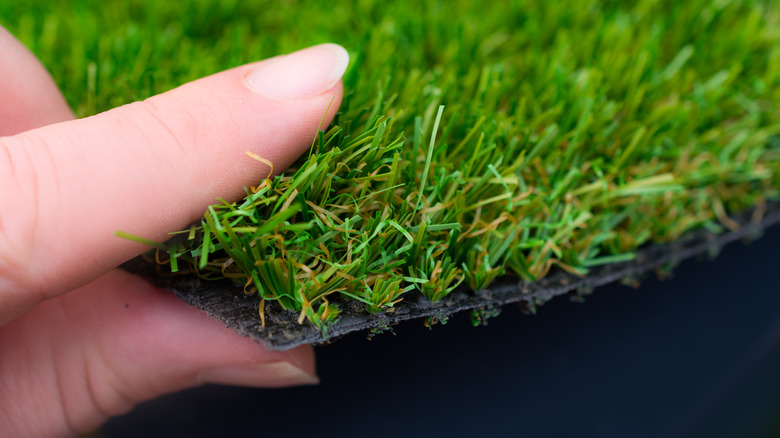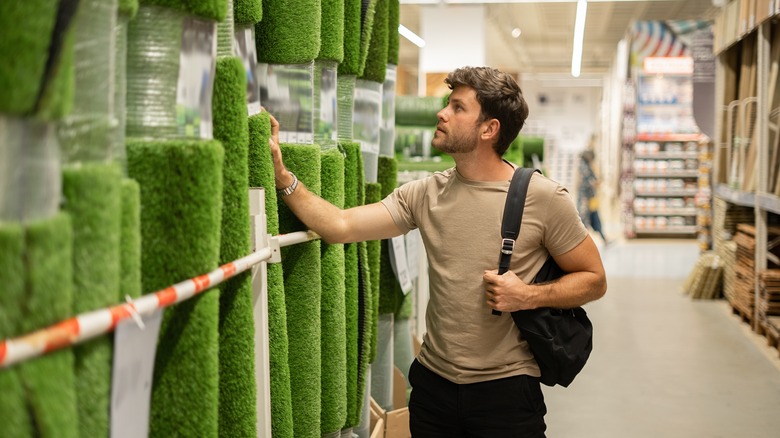11 Reasons You Should Steer Clear Of Artificial Grass
There is something appealing about artificial grass, isn't there? When it rains, it doesn't grow, so you don't have to mow it. It never dries up and turns yellow under the sun, and is oftentimes so well made that one could easily be fooled into thinking that it is real grass. However, all is not well under the sun. In fact, more often than not, artificial grass can be more trouble than it's worth.
Landscaping expert Roy Altaras, owner of Roy Altaras Landscape Design and Build, a licensed landscaping company based in Los Angeles, California, spoke exclusively to Outdoor Guide about why people should steer clear of synthetic turf. "We try to eliminate anything plastic in our designs," he said.
Alaras notes that, at the end of the day, when artificial turf is put down, it disrupts the natural ecosystem of the lawn and can actually cause more harm than good. "The benefits are smaller than its drawbacks," he said. With that in mind, and with guidance from Mr. Altaras, here are 11 reasons you should steer clear of artificial grass.
Fake grass can destroy and pollute soil
Artificial grass is just that: fake. It is a manufactured material that sits over the soil, and does not directly contribute energy or nutrients to the surrounding landscape. "The main reason to steer clear of artificial grass is to maintain a healthy environment, locally and globally. Plus, to achieve harmony in the landscape, there's nothing like living in green and natural materials," says Altaras.
"Artificial turf used in the landscape, especially when installed professionally, chokes the soil and prevents it from breathing," explains Altaras. When soil cannot breath, the organisms in it cannot grow. This includes beneficial insects like earthworms, microbes, and other bacterium.
If the worms and other organisms cannot get the food or air they require due to the fake covering, the soil dies and becomes degraded. And degraded soil can have a massive, negative impact not just on your landscape, but the surrounding landscape as well. Landslides, floods, compaction, and decreased biodiversity are all the result of degraded soil. Artificial grass plays a major role in this issue.
Artificial grass can make your yard too hot
When proper grass interacts with the sun, it behaves like an enormous solar panel. It takes in energy from sunlight though photosynthesis, capturing all of it and passing it along to insects, bacteria, and grazing animals that feed upon grass. Conversely, when you lay down artificial turf, none of this happens. "It heats up and does not photosynthesize," notes Altaras.
Instead of dispersing the energy to the soil below and its hungry critters, artificial turf will continue to absorb the heat and hold onto it. As a result, artificial lawns can get hot. Very hot. In fact, according to Safe Healthy Playing Fields, Inc., artificial turf often reaches temperatures as hot as 180 degrees Fahrenheit under direct sun, which is hot enough to melt shoe soles. If it can do that to shoes, imagine what it could do to your feet?
Walking barefoot on artificial turf that's been baking to 180 degrees is downright harmful. You could very easily get blistered, burned, and even suffer from other heat-related illnesses like heat stroke or exhaustion if exposed to those temperatures for too long. Artificial turf does nothing to cool down your yard on an already hot day.
It cannot be recycled
As previously stated, one of the primary drawbacks to artificial turf is the fact that it is not a naturally occurring product. The materials used are those you'd typically find in shoe soles and car tires. In a sheet or roll of artificial turf, you'll find polyethylene, polypropylene, and nylon, to name a few. These are used to mimic the look of grass and sit atop layers of padding that are often constructed of pure plastic or rubber.
While some artificial grass is produced as recycled bi-product of plastics and rubber material, the dirt and general debris that gets imbedded into the material during its use means that the stuff cannot be recycled. Many recycling plants require elements to be separated, so the fact that artificial grass is produced using a combination of materials is already working against it. Plus, plastics that contain heavy amounts of soil or grit cannot be recycled.
Since artificial grass cannot be properly recycled, it is destined for one place: the landfill. Plastics can take anywhere from 20 to 500 years to fully decompose. So, fake grass will continue to pollute the earth, even after the stuff has left your yard.
Fake lawns don't benefit the environment
It should come as no surprise that layering down plastic over a once thriving, natural landscape is not going to do the environment any favors. However, long before the stuff even touches the earth, the harm to the environment begins in the manufacturing process. "It is not eco-friendly in its fabrication," Altaras shared. It's not only the pollution produced by manufacturing that negatively affects the environment. That pollution follows the turf all the way to your home.
The chemicals utilized in manufacturing artificial turf will leach into the soil, creating a toxicity that could very easily spread into your neighbor's yard. Unfortunately, once the chemicals have become embedded in the soil beneath, it is practically impossible to remove them. The additional micro plastics released from the material will also create toxicity in the soil, and easily wash out into storm drains.
Then there is the issue of carbon. While natural grass acts as a lock for carbon, digging it up to replace with artificial turf releases all of that carbon into the atmosphere. . Since artificial turf cannot photosynthesize, it cannot lock carbon. Plus, because it is blocking the earth beneath, fake turf does not allow the ground to reabsorb carbon. All it does is heat up and off-gas until the day it's replaced.
Surface runoff can be a major issue
Another reason that artificial turf is bad for the environment and consumer safety is the fact that it does not hold onto moisture at all. Where natural grass and soil are porous and will take in and hold onto water, any accumulated moisture on artificial turf will just slide right off. While this won't be an enormous problem in a light drizzle, a heavy rain could spell disaster for your yard and potentially your neighborhood.
As the soil beneath the fake grass needs to be compacted for proper installation, any good rain storm is going to cause surface runoff that could very easily damage your yard, as well as the yards of your neighbors. Water prefers to take the path of least resistance. And seeing as it's not being properly absorbed into the ground thanks to the artificial turf, the water is going to head in whatever direction it can. Whether that's your garage or basement or the house next door, it makes no difference.
Even if the rain is not heavy, it'll remain on your lawn for days. So, you'll need to install an additional drainage system that you likely wouldn't have needed in the first place if you'd just hung onto your lawn's natural grass.
They look worse over time
Many of us think of artificial grass as the obviously fake, neon green rugs that are thrown down outside of an RV to replicate "a lawn." However, as Altaras notes, "Synthetic turf has evolutionized greatly in the past two decades in America and worldwide, and we see more and more installs in properties everywhere. It is a great product with high quality, and if properly landscaped in the right balance, it can deceive the eyes." Still, the fact is that, with time and use, the lawn is eventually going to show its true colors.
Nothing lasts forever. While natural grass will heal itself over time thanks to its tendency to grow, artificial grass will continue to show wear and tear the more it is used and exposed to the elements. And when that happens, your yard is going to look, quite frankly, terrible.
Unless you've really worked hard to level your landscape and make sure that all the seams of the turf line up perfectly, your yard is only going to look pristine for a short while. Eventually, it will start to wear. When it does, you're going to be looking at replacing it.
Fake lawns are expensive to install
The cost of organic seed for grass is negligible compared to the cost of installing artificial turf. According to Forbes, the price of grass seed can range anywhere from $1 to $50 per pound, depending on variety. Seeing as the recommended rate is 4 to 7 pounds of seed per 1,000 square feet, you're looking at less than $1,000 to seed your yard depending on its size. Compare that to landscaping company Ross NW Watergardens price of $25 to $35 per square foot for artificial turf, and you can immediately see which is the more economical choice.
That same 1,000 square feet would end up costing you $25,000 to $35,000 to install. And that price is just for the turf. It doesn't include taking up the grass, grading the surface, and actually installing the turf. Grading could set you back another $2,000 or $3,000, and installation labor could cost as much as $12 per square foot. This means your lawn will be several times more expensive if fake than it would be if real.
If this price tag doesn't phase you, we salute you. But for the average American homeowner, this amount is a lot to spend on installing a lawn that will eventually have to be replaced.
It's difficult to maintain
While it may seem like less maintenance to take care of an artificial lawn as opposed to a natural one, the fake lawn is not without its needs. One of the initial factors that draws buyers to purchase artificial lawns is the fact that they require no mowing whatsoever. While this may seem like it will free up your spring and summer weekends, keep in mind that, though it doesn't need to be mowed, the artificial turf still needs to be cleaned.
How is this done? Well, if you've ever seen someone brushing or even vacuuming their lawn, chances are those folks have artificial turf. Raking, brushing, and hosing the stuff will help remove the debris from your lawn, but depending on how large the square footage of your lawn actually is, this could actually end up taking a lot longer than you expect.
So, while installing the turf was supposed to save you time and money on watering and mowing, it will very likely end up eating that time back up from raking and brushing your yard. You have to admit, vacuuming your lawn sounds ridiculous.
Infill contains cancer-causing chemicals
If you've ever sat down on the artificial turf of a football field and run your hand along "the grass," you'll likely have noticed tiny pebbles of rubber coming up and bouncing alongside your hand. This is what's known as infill, and it weighs down the artificial turf so that it does not come up from the ground and fly away with a good wind. There is definitely cause for concern when it comes to infill. "[It] may also cause health issues for pets and humans if exposed to the skin for too long," said Altaras.
According to Dolman Law Group, "PFAS [forever chemicals] have been found in fields that utilize artificial turf and are considered a potential cause of cancer risk among [athletic] players that come into contact with this synthetic surface." The materials used on athletic fields are similar enough to what is used on residential to make the stuff a significant health risk to anyone who comes in close contact with it frequently, especially children and pets.
While ceramic sand is becoming more common to use as infill, there is still cause for concern when it comes to any kind of weighed-down artificial turf. While you would be correct in arguing that kids rolling around in grass that's been chemically fertilized is no better, the opportunity to fertilize grass organically is available. This is not so with artificial turf.
Artificial grass is not as soft as you think
While the tackled football player who bounces inches off the artificial grass-covered field may look as though he's collided with something soft and pliable, the fact remains that not all artificial turf is as soft as it looks. Remember, turf is essentially plastic that has been cut and layered to look like grass. It can therefore actually be sharp, because cut plastic is an abrasive material.
As such, a good fall could very easily cause turf burns, which is caused by heavy friction that can remove the top layer of skin, per Healthline. Unless you've managed to land on a thistle, the amount of physical damage sustained from a fall on regular grass is not going to account for more than a good bruise.
When you combine the sharpness of artificial turf with the heat it can accumulate on a hot day, you won't only get turf burn, but a proper burn, too. Remember, artificial turf can reach 180 degrees Fahrenheit in direct sun. So what is the point of having a lawn that you can't use for fear of it harming you? Artificial turf is really not conducive for families or anyone who purports to have an active lifestyle.
You'll need to replace it eventually
While you can get a long life out of natural grass, artificial turf is going to need to be replaced eventually. If you remember anything about the cost analysis from earlier, you'll know that you're going to be spending at least $30,000 to have a brand new, fake lawn installed. And while many artificial turf companies say the things last for upwards of 20 years, you are likely going to need to replace it much sooner than that.
Take into account all of the traffic on the lawn, the sun baking down on it and fading the colors, and the other natural debris that is going to pile up on it over the years, and that 20-year lifespan decreases dramatically. As you're watching professionals rip up and reinstall your lawn, you'll likely regret not just putting down seed and spending $300 on a push mower.
"To achieve harmony in the landscape, there's nothing like living in green and natural materials," said Altaras. He recommends using low maintenance, natural alternatives, like Sedges, and Kurapia drought tolerant ground cover, both of which add to the biodiversity of the yard, are environmentally beneficial, and look good, to boot.
